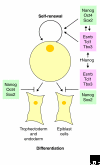Unraveling the transcriptional network controlling ES cell pluripotency
- PMID: 16942632
- PMCID: PMC1779601
- DOI: 10.1186/gb-2006-7-8-230
Unraveling the transcriptional network controlling ES cell pluripotency
Abstract
Embryonic stem cells (ES cells) are powerful tools for genetic engineering and hold significant potential for regenerative medicine. Recent work provides new insights into ES cell pluripotency and delineates separate transcriptional pathways in ES cells for maintenance of the undifferentiated state and for self-renewal.
Figures

Similar articles
-
Basic FGF and Activin/Nodal but not LIF signaling sustain undifferentiated status of rabbit embryonic stem cells.Exp Cell Res. 2009 Jul 15;315(12):2033-42. doi: 10.1016/j.yexcr.2009.01.024. Epub 2009 Feb 6. Exp Cell Res. 2009. PMID: 19331817
-
The transcriptional network controlling pluripotency in ES cells.Cold Spring Harb Symp Quant Biol. 2008;73:195-202. doi: 10.1101/sqb.2008.72.001. Cold Spring Harb Symp Quant Biol. 2008. PMID: 19478325 Review.
-
[Transcription factor network governing cellular pluripotency].Rinsho Ketsueki. 2009 Oct;50(10):1524-30. Rinsho Ketsueki. 2009. PMID: 19915362 Review. Japanese. No abstract available.
-
New insights into the control of stem cell pluripotency.Cell Stem Cell. 2008 Jan 10;2(1):4-5. doi: 10.1016/j.stem.2007.12.007. Cell Stem Cell. 2008. PMID: 18371412
-
Molecular basis of pluripotency.Hum Mol Genet. 2008 Apr 15;17(R1):R23-7. doi: 10.1093/hmg/ddn050. Hum Mol Genet. 2008. PMID: 18632692 Review.
Cited by
-
Genes for embryo development are packaged in blocks of multivalent chromatin in zebrafish sperm.Genome Res. 2011 Apr;21(4):578-89. doi: 10.1101/gr.113167.110. Epub 2011 Mar 7. Genome Res. 2011. PMID: 21383318 Free PMC article.
-
Acoustic vibration promotes in vitro expansion of human embryonic stem cells.Am J Stem Cells. 2024 Jun 15;13(3):143-151. doi: 10.62347/PJFC2708. eCollection 2024. Am J Stem Cells. 2024. PMID: 39021373 Free PMC article.
-
Differential roles of Sall4 isoforms in embryonic stem cell pluripotency.Mol Cell Biol. 2010 Nov;30(22):5364-80. doi: 10.1128/MCB.00419-10. Epub 2010 Sep 13. Mol Cell Biol. 2010. PMID: 20837710 Free PMC article.
-
Adult Neural Stem Cells: Basic Research and Production Strategies for Neurorestorative Therapy.Stem Cells Int. 2018 Apr 1;2018:4835491. doi: 10.1155/2018/4835491. eCollection 2018. Stem Cells Int. 2018. PMID: 29760724 Free PMC article. Review.
-
Cancer stem cells generated by alcohol, diabetes, and hepatitis C virus.J Gastroenterol Hepatol. 2012 Mar;27 Suppl 2(Suppl 2):19-22. doi: 10.1111/j.1440-1746.2011.07010.x. J Gastroenterol Hepatol. 2012. PMID: 22320911 Free PMC article. Review.
References
-
- Capecchi MR. Altering the genome by homologous recombination. Science. 1989;244:1288–1292. - PubMed
Publication types
MeSH terms
Substances
LinkOut - more resources
Full Text Sources
Other Literature Sources

